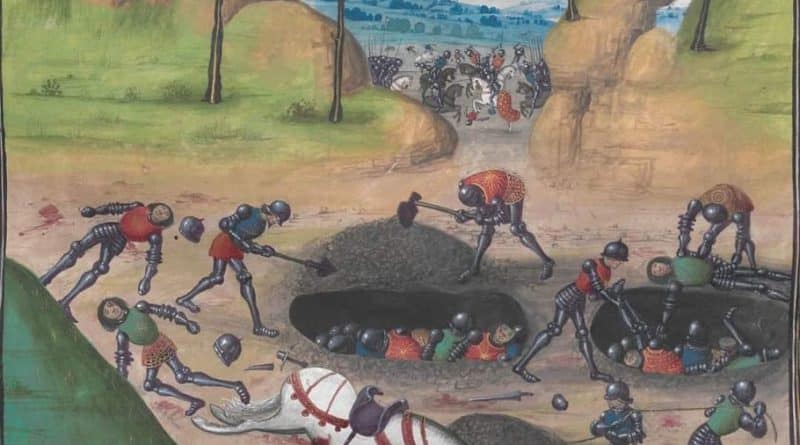Mass Graves and the disposal of Battlefield dead
What happened to the bodies of those killed in Medieval battles? Whilst the nobility who fell in battle would often be removed from the battlefield and entombed at a place of their families choosing, this was far from the case for the majority. In the case of larger battles, with thousands of dead, the matter of dealing with the corpses was one of urgency, to prevent the spread of disease, and logistically difficult. Solutions to the problem of many battlefield dead have varied over time and place. Some methods have been prevalent throughout: the use of mass graves being one such solution.
What happened to all of the dead from Wars of the Roses battles?
The dead from battles in the Wars of the Roses had their bodies treated in a number of ways.
Nobility
Nobles often had their remains taken from the battlefield and returned to their families. These can be evidenced through the various tombs and effigies of barons who fell in battles. These include the Earl of Warwick whose body was taken from the field at Barnet. His remains were displayed in St. Paul’s Cathedral before being handed to his brother, Archbishop Neville, who oversaw his burial in the family vault at Bisham Priory [Tomb no longer visible]. Others include Lionel, Lord Welles, who having been killed in the Battle of Towton was entombed in one of his manors, Methley, following the battle [Effigy remains accessible in the Parish church at Methley]. The Lancastrian Prince of Wales, Edward, was taken from his place of death and buried within Tewkesbury Abbey. King Richard III‘s remains were taken from Bosworth to Leicester and buried in the grounds of Greyfriars. Henry VII paid for a tomb for the defeated king. Famously, the tomb and Richard’s remains later became ‘lost’ until being rediscovered in 2012, then reburied within Leicester Cathedral.
The common soldier
The bulk of war dead were not nobles, or gentry. They were the men arrayed to fight under their lord, or on behalf of the town in which they resided. These men may have been experienced soldiers but with no particular rank, or substantial funds available to their families, were often not afforded an individual burial. Disposal of these corpses was important in the days after a battle. Large numbers of bodies in a relatively small area presents a risk to health: something that was appreciated at the time. So solutions were in place that dealt with large numbers of dead in an efficient manner.
The use of mass graves was one such method. These large pits have been discovered at or near to many medieval battlefields. They vary in size and rarely account for a large percentage of those thought or known to have died in a battle.
Towton Skeletons
One of the best known examples of a mass grave from the Wars of the Roses is one of the sites discovered at Towton. This mass grave was excavated by a team of Archaeologists led by Tim Sutherland. His video about the excavation of skeletons from this site is below:
Towton Mass Graves Project website.
Other mass graves from the Wars of the Roses
At Northampton it is written that there are mass graves. The exact location is not confirmed though there is visible evidence that may indicate where if examined by archaeologists. The Northamptonshire Battlefields Society note these sites. Sources also note that the Lancastrian dead were refused a christian burial as they had been excommunicated prior to the battle. These bodies would still need removing though, most likely into a mass grave.
A mass grave exists near the site of the Battle of Mortimers Cross. Details here.
At Barnet there are references to a mass grave known as ‘Deadmans Bottom’ in texts. However the location has not yet been identified. Details here.
A mass grave is located in the churchyard of St John’s which contains remains of men who fought in the Battle of Nibley Green.
A number of mass graves exist close to the site of the Battle of Stoke. Brief information is on the Battlefields Trust website.
Links
Curry, A., & Foard, G. (2016). Where are the dead of medieval battles? A preliminary survey. Journal of Conflict Archaeology, 11(2–3), 61–77. https://doi.org/10.1080/15740773.2017.1324675
Medieval cemeteries . These are not battlefield related but are a selection of medieval cemeteries in London for which records and data are available.
Medievalists – Battlefield Injuries. This article uses finds from mass graves to explore the types of injury suffered by those who died in various medieval battles, including Towton.
Historika. This page exlores finds relating to the Battle of Gotland / Visby. The remains discovered here are unique in that the bodies were buried in armour, meaning that there is a record of what was worn and the arms carried. Some of the armour is now on display, as shown in this page.
Featured image
Mass Grave. From Wavrin’s Chronique d’ Angleterre
